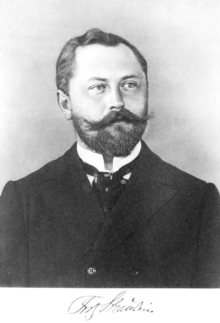Fritz Schaudinn facts for kids
Quick facts for kids
Fritz Schaudinn
|
|
|---|---|

Fritz Schaudinn
|
|
| Born | 19 September 1871 Röseningken, Province of Prussia
|
| Died | 22 June 1906 (aged 34) |
| Nationality | German |
| Known for | medical advances against ...; protozoology |
| Scientific career | |
| Fields | zoologist, protozoologist, microbiologist |
Fritz Richard Schaudinn (born September 19, 1871 – died June 22, 1906) was a German scientist. He was a zoologist, which means he studied animals. He also became a microbiologist, focusing on tiny living things like bacteria and protozoa. Schaudinn made very important discoveries that helped doctors understand and fight serious diseases.
Contents
Who Was Fritz Schaudinn?
Fritz Schaudinn was born in a place called Röseningken, which was in Prussia (now part of Russia). He studied zoology at the Friedrich Wilhelm University in Berlin. After finishing his studies, he became a brilliant researcher. He was especially interested in protozoology, which is the study of tiny, single-celled organisms called protozoa. He helped make protozoology a key part of experimental science.
Important Medical Discoveries
Schaudinn made many breakthroughs in medicine. His work often involved studying how tiny organisms cause sickness.
Fighting Amoebic Dysentery
One of his big achievements was in understanding amoebic dysentery. This is a severe stomach illness caused by a type of amoeba. Schaudinn's research helped explain how this disease spreads and affects people.
Research on Sleeping Sickness
He also worked on sleeping sickness. This serious disease is spread by insects and affects the brain, causing extreme tiredness. His studies helped scientists learn more about the tiny parasites that cause it.
Confirming Malaria Research
Schaudinn also helped confirm the important work of other scientists, Sir Ronald Ross and Giovanni Battista Grassi. They were researching malaria, a disease spread by mosquitoes. Schaudinn's findings supported their ideas about how malaria works.
Understanding Hookworm Infection
He discovered how people get hookworm infection. This is a type of parasite that lives in the intestines. Schaudinn showed that people usually get hookworms through the skin on their feet, often by walking barefoot in contaminated soil. This discovery was very important for preventing the infection.
Studying Arctic Animals
In 1898, Schaudinn went on a scientific trip to Svalbard with another zoologist, Fritz Römer. Svalbard is a group of islands in the Arctic Ocean. They studied the animals living in that cold region. Their expedition led to a big project called Fauna Arctica. This project aimed to describe all the animals found in the Arctic. Other scientists continued this work after Schaudinn.
His Legacy
Fritz Schaudinn died at a young age, just under 35 years old, in Hamburg. He passed away during his journey back to Germany from a medical meeting in Lisbon. He had to have emergency surgery because of serious infections in his stomach caused by amoebas. It is believed that he might have gotten this infection while doing research on amoebas.
Even though he died young, Schaudinn left a lasting impact on science and medicine. His work helped save many lives by improving our understanding of diseases. Since 2002, an annual medical prize has been given out in his name to honor his contributions.
See also
 In Spanish: Fritz Schaudinn para niños
In Spanish: Fritz Schaudinn para niños

